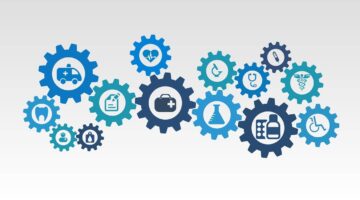Microsoft’s cool sequel to Kinect, a technology that uses smart goggles called HoloLens combines augmented reality, 3D and collaborative technology with holograms.
It has some compelling implications for healthcare that include simulations, medical education and medical device development.
An overview of the device was presented as part of Microsoft’s Windows 10 preview. But a set of tech journos got to play with the HoloLens can run independently from a computer or phone. TechCrunch noted that it has its own CPU and GPU.
The main complaint from reporters who tried out the device was that the goggles were a bit uncomfortable on top of their glasses. It’s also larger and not quite as elegant as Google Glass.
The Verge’s reporter noted that there’s a small, heavy block that hangs around your neck which contains all the computing power and includes lenses, tiny projectors, motion sensors, and speakers.
Wired offered a great profile of the chief inventor behind HoloLens — Alex Kipman, who has been working with a team to develop the technology for the past five years. It said that users can manipulate the holograms using gesture control referred to as holding, but engineers are continuing to still fine tuning it.
In an interview with Kipman, he described how HoloLens works:
Project HoloLens’ key achievement—realistic holograms—works by tricking your brain into seeing light as matter. “Ultimately, you know, you perceive the world because of light,” Kipman explains. “If I could magically turn the debugger on, we’d see photons bouncing throughout this world. Eventually they hit the back of your eyes, and through that, you reason about what the world is. You essentially hallucinate the world, or you see what your mind wants you to see.”
To create Project HoloLens’ images, light particles bounce around millions of times in the so-called light engine of the device. Then the photons enter the goggles’ two lenses, where they ricochet between layers of blue, green and red glass before they reach the back of your eye. “When you get the light to be at the exact angle,” Kipman tells me, “that’s where all the magic comes in.”
One of the most interesting demonstrations for the HoloLens Microsoft made available was the integration with Skype (above). A father offers guidance on how to reassemble a pipe fix some plumbing in his daughter’s home. He can see her point of view and highlight areas that need attention with a pen and those marks can be easily identified by the daughter.
The twittersphere produced a few mentions about the potential healthcare uses including from Bill Crounse, the senior director of worldwide health at Microsoft.
Doctors start your engines. A new era in #medical education, simulations, and patient engagement is on the horizon. http://t.co/3a72EygqVI
— Bill Crounse, MD (@MicrosoftMD) January 21, 2015
@maryjofoley hololens idea – medical application to overlay xrays and mri scans etc. onto the patient — Iain Alexander (@iainalexander) January 22, 2015
You could imagine a surgical team using the it in a simulation to prepare for a complex surgery. Or to make medical consults more interactive. Biomedical engineers could use the technology to develop more customized devices.
Physicians could also use HoloLens to give patients a better understanding of an upcoming procedure. Crounse, in response to a tweet, said the goggles could also be used for telemedicine, remote monitoring, 3D medical modeling, training, guided examinations and virtual care, among other things.
Of course, the price tag will have a big impact on how widely accessible HoloLens is to these kinds of use cases.
Update: This post was updated with additional information from Bill Crounse, the senior director of worldwide health at Microsoft.










